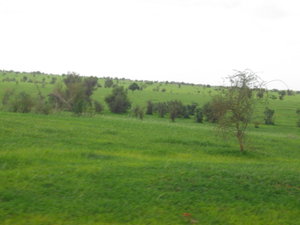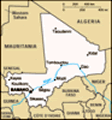Advertisement
Published: September 22nd 2010

 edge of the Sahara
edge of the Sahara
it's all green in the rainy seasonAfter two hot days hitching along the Senegalese highway towards Mali, it seemed time to get back onto dirt roads. The border crossing took only five minutes of formalities (including a failed attempt to talk my way in sans visa), then it was south from Kayes travelling along a classic African red-gravel road passing giant baobabs, tiny villages, and impressive rock faces that extend from the nearby mountainous Guinean border.
An unexpected eye-opener on this leg of the trip was the three big mining towns distributed along the route. The West African gold trade is one activity that has drawn the world’s attention for centuries, from the Ghana Empire of the fifth to twelfth centuries to the modern abuse that can be seen along that road in western Mali. The many beautiful hills that were once home to chimpanzees and baboons - the same habitat as in the Fouta Diallon in Guinea - have now been reduced to exhausted barren islands protruding from the surrounding sea of green forest, tiring the eyes and leading one to question how we can destroy the true natural beauty of our planet and replace it with fancy jewellery and gold-plated dinnerware. And for westerners

 tourist picture!
tourist picture!
classic Timbuktu tourist pose, complete with a Tuareg who shrug off the destruction of the environment in the third world as ‘their problem’, please don’t forget that it is western companies - Canadians, above all - who are financing, implementing, and reaping the rewards of that indifference. A Canadian expat journalist who I stayed with in northern Mali recently wrote an article on this topic for Reuteurs Magazine, outlining the role Canadian companies play in the Ghanian mining industry, I cant find the link with this slow internat but Im sure it would be an interesting read.
Bamako is a sprawling, busy capital buzzing with thousands of mopeds, street vendors, and a colourful mix of people from all corners of West Africa and the world. It is a city saved from the dreary greyness of other capitals by the greenery delivered along the Niger River, which attempts to force a relaxed pace on the city by slowing down any traffic trying to get from one side to the other on its two two-lane bridges. For me, Bamako was on the list only as a stop to buy visas for other countries, but it turned out as a great experience thanks to the wonderful people I stayed with.

 Peace Monument
Peace Monument
After the peace deal between the Tuaregs and the Malian government ended the war, they collected all the weapons, buned htem, and cemented them into the Timbuktu peace monumentThe first was the family of the boss of a truck driver I had hitchhiked with a few days before, and then it was couchsurfing with Noumoke, a sports journalist for a Malian radio station. The best part of those four days (apart from the incredible motherly kindness of Noumoke’s mom) was free, great seats to the Coupe du Mali, and finally getting to say “I’m with the press” (journaliste, Radio Toronto 😉.
One destination that had long been on my travel itinerary, mostly for reasons involving my brother’s lost croquet balls, was Timbuktu, the last city northward in Mali before the Sahara completely takes over. Despite the minor apprehension brought on by the constant talk of Al Qaeda (or more specifically, AQIM - Al Quaeda in Islamic Maghreb), the road was fine and I was reassured by the loaded Kalashnikov seated between myself and the police officer who gave me a ride. Ended up spending the whole month of Ramadan there, partly because Kalil, Khadija, Bamoye, Mohamed, D.J., Baby, Alumadan and Ousman had quickly become family, and partly because trying to travel in the hot Sahel on foot while fasting (i.e. without water) seemed like it would be

 dinnertime on the terrace
dinnertime on the terrace
Khadija, Baby, Alumadan, Ousman, Mohamed & Icrossing the line of discomfort just a little too far. So Timbuktu it was, every morning getting up at 4 a.m. to have a breakfast of bouiy, a type of liquidy porridge made by boiling little balls of flour; spending the (relatively) cool mornings practicing motorcycling through sand dunes or taking trips to fish or swim in the Niger river (they promised the hippos keep away from the sandy beach); passing the hot afternoons relaxing out of the sun, and then breaking the fast at sundown with kankalibas (tea), dates, bany hadi (a type of spicy sour milk), juice, more bouiy, and plenty of water. We always had a big delicious dinner before bed, and often there was a second plate sent over by a neighbour or family member, as Muslims consider Ramadan an especially important time for generosity. The three-day ‘party’ at the end of the month was fun, although it mostly consisted of getting dressed up really nice and walking around town greeting people in languages I don’t understand (like Sorhaiy, Tamashek (Tuareg) and Bambara); I’d say it is a better time for kids, who get to go house to house trick-or-treating for money.
Left Timbuktu in

 Ramadan cooking
Ramadan cooking
Preparing meatballs stuffed with hard boiled eggs to give out to friends and family for Ramadanstyle: hanging on tight in the back of a pickup packed with Arabs and merchandise. Spent a few days walking across the very green Dogon falaise, and then crossed into Burkina for a few more days walking and getting the odd ride through the north. At the moment, hitchhiking has become so easy that signalling for rides is no longer necessary; on the small roads, if one of the few vehicles that passes has a place, they’ll stop to make sure I’m okay and usually offer a ride. Solidarity 101. Now for a little more Burkina, then the southern countries.
Advertisement
Tot: 0.286s; Tpl: 0.012s; cc: 13; qc: 67; dbt: 0.0636s; 1; m:domysql w:travelblog (10.17.0.13); sld: 1;
; mem: 1.2mb
















edmond wango
non-member comment
le porc cest toute ma vie
jaime telment le porc ke je la mange presque tout les jours cest propre et je laimerai toute ma vie